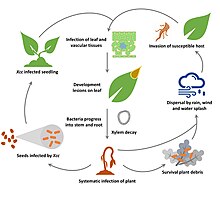Xanthomonas campestris
These bacteria are facultative saprophytes, meaning that they are typically parasitic while also having the ability to live on dead or decaying organic matter under the proper conditions.[1][3][4] Additionally, the virulence determinants associated with the seedborne diseases that result from this bacterium include extracellular enzymes, polysaccharides, lipopolysaccharides, etc.Further investigation of pathogenicity profiles and multilocus sequencing typing suggested that the list could be narrowed down to just three main pathovars with the different symptoms being black rot, leaf spot, and bacterial blight.incanae (known for causing bacterial blight of garden stocks) are vascular pathogens, and they have been found to invade the plant host through wounds or hydathodes.[3][2] Therefore, the bacteria are initially in the epiphytic stage of the infection cycle, which is when they grow on the surface of the plant, such as on the aerial tissues of leaves and fruit.[2] Then, biofilm matrices composed primarily of xanthan will form, which will help the bacteria to survive in the harsh abiotic conditions of the plant surfaces.Eventually, the bacteria enter the host tissue through natural openings such as pores and stomata, or wounds, which is hypothesized to be a result of chemotaxis.[2] Xanthomonas campestris is commonly used industrially to produce a water-soluble exo-polysaccharide, known as xanthan gum, from fermentation of carbon sources like glucose.Therefore, as the microorganism grows, there is production of xanthan, which is secreted from the bacterial cells and ultimately recovered from the media and purified using alcohol precipitation techniques.

Scientific classificationBacteriaPseudomonadotaGammaproteobacteriaXanthomonadalesXanthomonadaceaeXanthomonasBinomial nameType strainSynonymsgram-negativeobligate aerobicXanthomonas campestris pv. campestriscruciferous vegetablessaprophytesparasiticepiphyticendophyticavirulencepathogenicitypathogenicity factorspolysaccharideslipopolysaccharidesxanthan gumpathovarsX. campestrispv. campestrispv. raphaniX. campestris pv. campestrishydathodesstomataparenchymatype II secretion systemtype III secretion systemhypersensitivity responsevirulenceendoglucanaseproteaseextracellular polysaccharideadhesion proteinstype IV pilibiofilmabioticchemotaxisvascular systemexo-polysaccharidefermentationgram-negative bacteriumbioreactorsgrowth mediabatch fermentationalcohol precipitationagricultural industryoil industrypharmaceutical industryBecker, AnkeBibcodeWikidataWikispeciesBacDiveiNaturalistOpen Tree of Life